Submission for ECDL 2001 OAI Workshop
Enhancing OAI Metadata for Eprint Services: two proposals
Tim Brody, Zhuoan Jiao, Steve Hitchcock, Les Carr and Stevan Harnad
Open Citation Project,
IAM Research Group, Department of Electronics and Computer Science,
University of Southampton SO17 1BJ, UK
Contact email: sh94r@ecs.soton.ac.uk
The Open Citation project is
funded by the Joint
NSF - JISC International Digital Libraries Research Programme
Version history of this paper
-
First draft (10 July 2001) submitted to the Experimental OAI-based Digital Library Systems Workshop to be held in conjunction with the 5th European Conference on Research and Advanced Technology for Digital Libraries (ECDL) September 8, 2000
-
This version is also available in PDF.
Abstract: The Open Archives Initiative has always maintained a distinction between
data providers and service providers. This works at a functional level;
some current projects are showing that it is less significant at an operational
level. The Open Citation project harvests reference data from full-text
eprint archives for reference linking, citation analysis and citation-ranked
search. These are regarded as service provider functions where the end-user
interacts directly with the services. The aim is to make these data available
for export back to the full-text archives and to other service providers.
Thus OpCit becomes a data provider too. The current Open Archives Protocol
for Metadata Harvesting says nothing about full-text data harvesting for
services such as these, nor about the export of processed data. This short
paper outlines two proposals for progress on these issues.
1 Introduction
Emerging Open Archives services are blurring the distinction between data
and service providers introduced in the original Santa Fe Convention framework
documents describing the Open Archives Initiative (OAI). (Van de Sompel
and Lagoze 2000) This is highlighted by the recently announced Kepler framework,
a broker-based peer-to-peer network architecture, such as that used by
Napster, which provides individual authors with software to set up personal
archives, hosts a registration server and harvests data for subsequent
dissemination. (Maly et al. 2001) This blurring between provider
functions has significant practical implications for OAI.
The OAI Protocol for Metadata Harvesting (Van de Sompel and Lagoze 2001)
mandates simple, Dublin Core based metadata to achieve interoperability
between archives with low overhead for archive maintainers. This focus
on simplicity would appear to be vindicated by the apparent demise of NCSTRL,
a forerunner of OAI as a collection of distributed archives. (Krichel and
Warner 2001b) It suggests, however, the expectation of data transfer between
services at a fairly low level of functionality unless OAI data and service
providers can supplement the basic metadata for particular application
areas, as allowed in the OAI protocol.
An example of enhanced metadata is the proposed Academic Metadata Format
(AMF), a parallel metadata set that can be deployed with basic OAI metadata
and which is designed to be used by the eprint archiving community, or
more generally 'to advance scholarly communication over the Internet'.
(Krichel and Warner 2001a)
This is a welcome development. Once an OAI service provider itself becomes
a data provider, it is inevitable that data output in this case will not
be simple document metadata as offered by the original document archives
(which might be a better distinction than 'data provider'), otherwise,
what service would the service provider be offering?
This paper considers the enhancement of OAI metadata from the perspective
of the Open Citation (OpCit) project, which is demonstrating reference
linking and citation analysis services by working with the largest OAI-compliant
archive, the Los Alamos physics archives (arXiv). The approach described
is intended to be generalised for other Open Archives, and is presented
here to promote discussion and participation in the process.
2 Reference linking and citation analysis
To provide reference linking and citation analysis requires more data than
is included in the OAI metadata. In principle, the full reference list
is required (the full text is required for in-text, context reference linking,
i.e. linking the occurrence of the citation within the text to the reference
at the end of the text). OAI metadata does not provide mechanisms to expose
and harvest full content. (Warner 2001)
An early demonstrator of OpCit reference linking was described by Hitchcock
et
al. (2000). Since then the reference database continues to be kept-up-to-date
and has been restructured to store richer data, improving accuracy and
robustness. This has enabled the service to be extended, providing forward
linking citation analysis as well as a Google-like search service that
ranks results according to citations or hits.
The project has achieved this by working in partnership with the arXiv
maintainers. To extend this approach to other archives, the project confronts
two questions:
-
How can reference lists be extracted from Open Archives within the framework
of the OAI?
-
How can processed data be exported back to the original archives so that
it can be visible to the users of the archives (rather than as a standalone
demonstrator)?
Since OAI data is intended to be interoperable, and OAI service providers
are envisaged as cooperative, it is reasonable to assume that other services,
search engine or Web portal for example, not simply the original archives,
may also want to import the processed data. Thus a generalised interface
to expose the data is desirable.
In the OpCit application the schematic in Figure 1 shows data input
and output in the context of the OAI. The only parts of this schematic
mandated by the OAI are the target paper archives and OAI metadata output.
OpCit is responsible for the citation database and specified user services.
The subject of the questions above are the production of the reference
list and the data export (stages A and D, respectively, in the schematic).
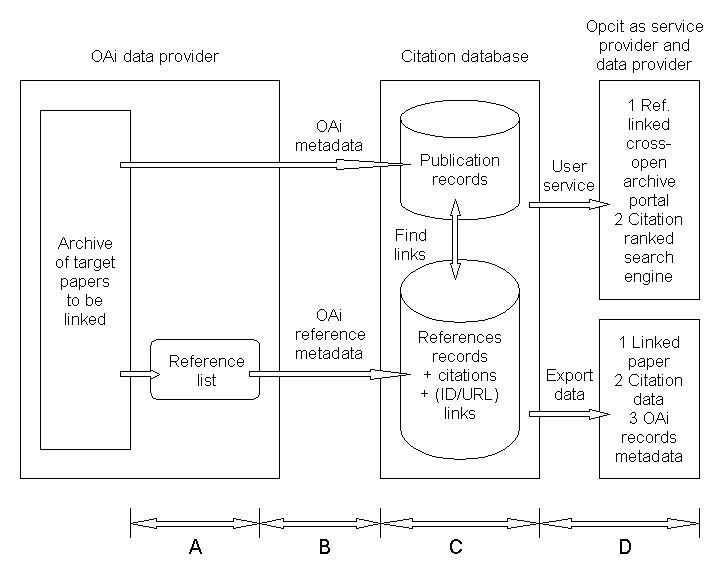
Figure 1. Proposed schematic of data input and output from the OpCit
citation database
2.1 Extracting and parsing reference lists
Experience of large archives shows that document maintainers are unwilling
to permit automated downloading of full texts. Alternatively, OpCit has
developed software to identify and extract reference lists from papers,
and this is available for free download and use by archive maintainers
to create a separate collection of reference list documents, saving the
main document server from possible overload.
This series of Perl modules is available from http://arabica.ecs.soton.ac.uk/code/doc/ReadMe.html,
and includes:
-
Markup_TeX.pm: inserts mark-up 'xxxOpCit' at the beginning of each reference
in the TeX source file. This mark-up is used by 'Parser_DVI.pm to identify
each reference;
-
TeX2DVI.pm: converts TeX/LaTeX to a DVI file, then DVI to text by 'dvitype'
(Unix command);
-
Parse_DVI.pm: parses the text file created by 'dvitype' to produce a list
of references;
-
Citation.pm: parses each reference (citation) string to discover its metadata
(authors, journal, volume, issue, etc.)
This software adds little manual overhead to maintenance beyond initial
set-up, and imposes no requirements on authors. Initially these modules
are optimised for arXiv because of the common TeX format found there, although
other versions have been used with pdf and html. Perl scripts which make
calls to the above modules can be developed locally.
2.2 Citation database
The parsed reference data extracted using these scripts are stored in the
classic citation database structure shown in Figure 1 along with the conventionally
harvested OAI metadata. Comparing the reference records with the publication
records for an archive enables links to point at those referenced documents
held in the archive. Also, for each publication record it is possible to
use the reference records to determine if it has been cited. This can be
displayed in a number of ways, as shown in Figure 2.
Within the project this database, called cite-base, is also used to
serve the cite-baseSearch engine (http://cite-base.ecs.soton.ac.uk/cgi-bin/search)
that ranks results according to citations or hits, as selected by the user.
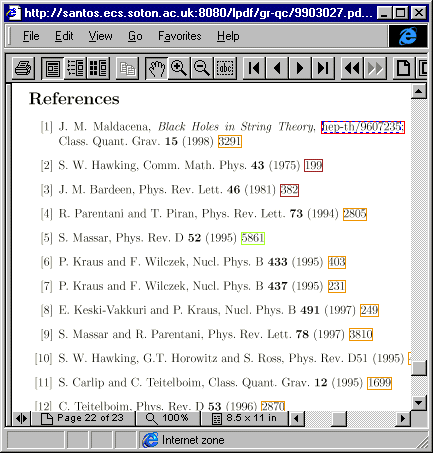
a |
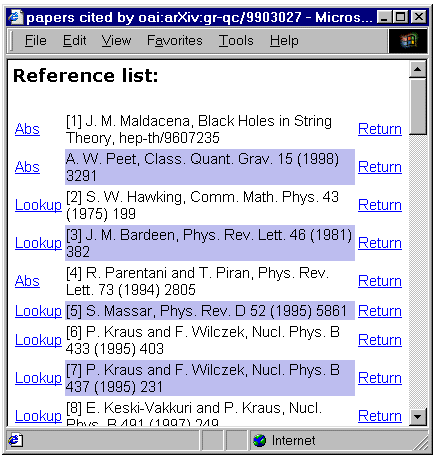
b |
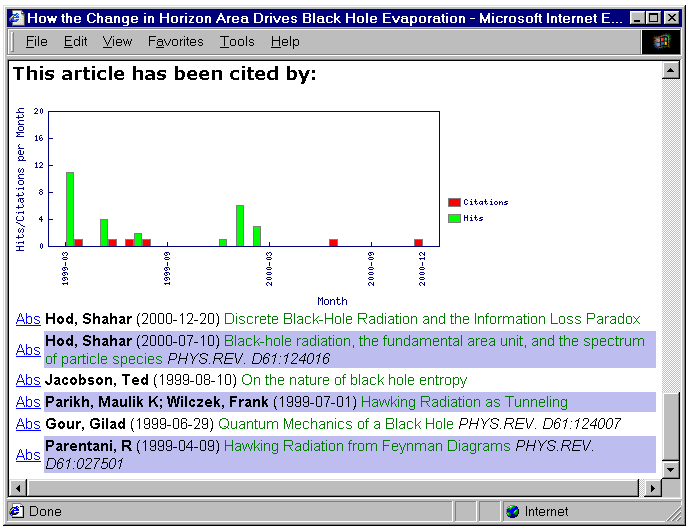
c
Figure 2. Reference and citation lists for a paper in the physics archives:
a, reference links added to the original pdf; b, the same reference list
extracted from cite-base with direct links (Abs) to texts and Lookup links
to search for e.g. other works by the cited authors where the cited document
is not available; c, citations to the same paper from which the
reference list was taken.
2.3 Data export
While the project is capable of managing data capture, database maintenance
and the user interface within the current framework, a more intriguing
prospect is exporting data, principally back to the archive maintainers
so that the services demonstrated above can be made available to users
of the archive, but also to other OAI service providers.
OpCit's immediate requirement is for a metadata format to express the
reference lists (and hence the referenced articles), along with fields
such as title, abstract, etc. This can be expressed using Dublin Core metadata,
specifically the relation attribute. An in-house format, "opcit_dc"
(Figure 3), augmenting Dublin Core with a citation attribute, was
developed to store structured data for references (title, author, year
of publication). Citation allows the reference and linked identifier
to be expressed (with hindsight this is probably possible using Dublin
Core qualifiers, without having to modify the schema).
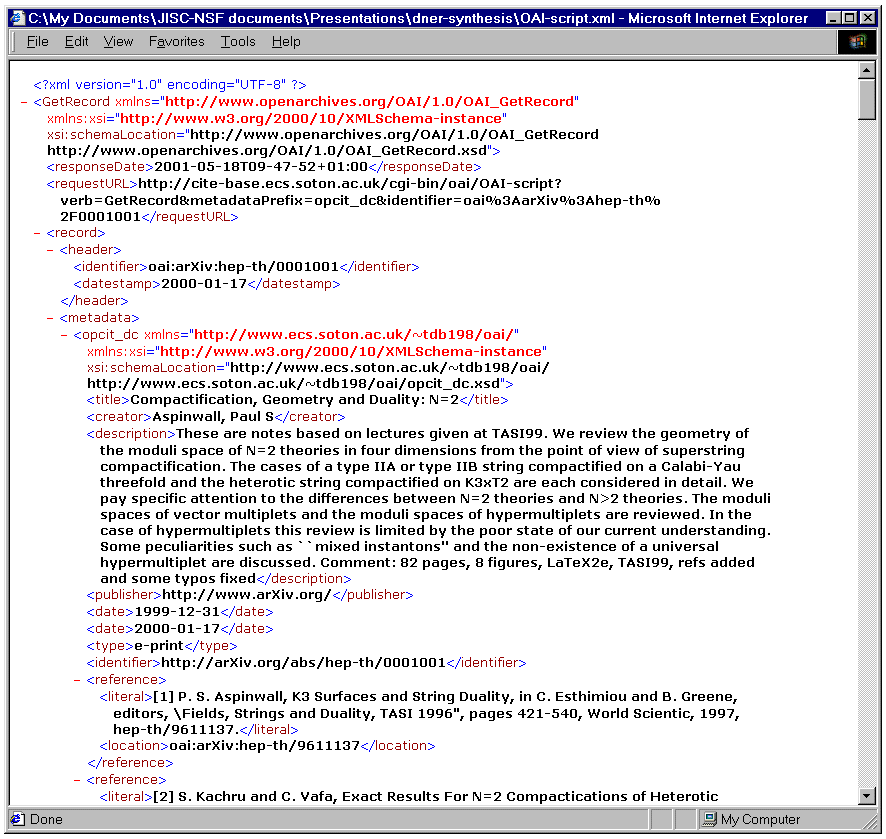
Figure 3. Example citebase record in "opcit_dc" format
The development of the AMF offers the chance to extend this approach
for OpCit and OAI archives that handle research papers. AMF is a relational
model for data, e.g. two documents are related by a reference. These relations
can be expressed in either direction, e.g. AMF can express all the papers
by an author, or all the authors of a paper. AMF will work best when the
"noun" objects (texts, people, organisations), can be uniquely identified,
which will require new identification systems. Current metadata is quite
"weak", so the ability to be able to compare the impact of authors, say,
is difficult within a large community.
It is planned to use AMF to transfer reference data between OpCit and
arXiv. Another Open Archive, RePEc (Krichel and Warner 2001b), which is
a database of papers on economics, plans to use AMF to implement the OAI
protocol, and such a rich information resource could be used by others
to implement, e.g. academic Web portals.
3 Conclusion
The Kepler framework is allied with a federated OAI search service called
Arc. Data harvesting by Arc revealed that not all archives strictly follow
the OAI protocol, and although the OAI validates registered data providers
for protocol compliance and conformance with XML, this verification is
not complete. (Liu et al. 2001) There are two possible responses:
at the level of the OAI protocol, or work-around solutions by service providers.
It seems clear the OAI wants to boost content-based archives by offering
as few barriers as possible to data providers, so the Arc developers seem
to anticipate the latter response.
In the case of the Open Citation project and arXiv, service and data
providers together recognise the need to supplement the basic OAI
metadata to improve functionality and performance.
Two proposals for the OAI community to consider emerge from this brief
description of the reference linking and citation analysis work of the
Open Citation project:
-
Richer formats are required to supplement the basic OAI metadata and to
expose data for transfer between service providers and archive maintainers.
The Academic Metadata Format appears to be a good foundation for this,
and others are encouraged to participate in the development and review
of AMF so that it might be adopted with some consensus.
-
Reference lists need to be available for automated download from archives.
Modular software aimed at archive maintainers, which automates the extraction
and mark-up of references from submitted papers, is available for free
download from the OpCit project.
References
Hitchcock, Steve, et al. (2000) Developing Services for Open Eprint
Archives: Globalisation, Integration and the Impact of Links. Proceedings
of the Fifth ACM Conference on Digital Libraries (ACM: New York), 143-151,
June. Version available at http://opcit.eprints.org/dl00/dl00.html
Krichel, Thomas and Warner, Simeon M. (2001a) A Metadata Framework
to Support Scholarly Communication. Submitted to the Dublin Core Conference,
Japan, October. Draft available at http://openlib.org/home/krichel/kanda.html
Krichel, Thomas and Warner, Simeon M. (2001b) Disintermediation of
Academic Publishing through the Internet: an Intermediate Report from the
Front Line. ICCC/IFIP Conference on Electronic Publishing, Canterbury,
UK, July. http://openlib.org/home/krichel/sants.html
Liu, Xiaoming, et al. (2001) Arc - An OAI Service Provider for
Digital Library Federation. D-Lib Magazine, Vol. 7,
No. 4, April. http://www.dlib.org/dlib/april01/liu/04liu.html
Maly, Kurt, Zubair, Mohammad and Liu, Xiaoming (2001) Kepler - An OAI
Data/Service Provider for the Individual Access. D-Lib Magazine,
Vol. 7, No. 4, April. http://www.dlib.org/dlib/april01/maly/04maly.html
Van de Sompel, Herbert and Lagoze, Carl (eds) (2001) The Open Archives
Initiative Protocol for Metadata Harvesting. Protocol Version 1.1, 2 July.
http://www.openarchives.org/OAI/openarchivesprotocol.htm
Van de Sompel, Herbert and Lagoze, Carl (2000) The Santa Fe Convention
of the Open Archives Initiative. D-Lib Magazine, Vol. 6, No. 2,
February. http://www.dlib.org/dlib/february00/vandesompel-oai/02vandesompel-oai.html
Warner, Simeon (2001) Exposing and Harvesting Metadata Using the OAI
Metadata Harvesting Protocol: A Tutorial. HEP Libraries Webzine,
No. 4, June. http://library.cern.ch/HEPLW/4/papers/3/





